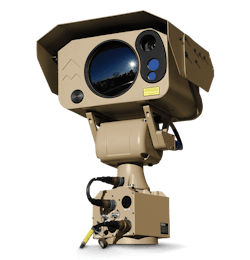FLIR Systems to upgrade persistent surveillance electro-optical sensors for Marine Corps perimeter security
CRANE, Ind. – Electro-optical sensors experts at FLIR Systems Inc. in Wilsonville, Ore., will upgrade and repair sensors that provide beyond-the-fence surveillance for U.S. Marine Corps installations under terms of $16.1 million contract announced last week.
Officials of the Naval Surface Warfare Center in Crane, Ind., are asking FLIR Systems for upgrades, repairs, spare parts, and engineering services to support the Ground-Based Operational Surveillance System (G-BOSS).
This persistent-surveillance system is a self-erecting, trailer-mounted tower that provides a stable, elevated platform for sensors and communications to provide beyond-the-fence surveillance for Marine Corps installations. The system is deployed in the Middle East and other locations for perimeter security.
Each G-BOSS tower can operate independently and has a 107-foot or 80-foot tower; a multispectral electro-optic/infrared sensor suite composed of a FLIR Systems Star SAFIRE IIIFP camera with a laser pointer and range finder; a FLIR Systems ThermoVision 3000 infrared camera with a global Positioning System (GPS); a man-portable surveillance and target acquisition radar (MSTAR); a ground-control station; and optional remote ground station.
G-BOSS can integrate signals from unmanned aerial vehicles (UAVs) using the VideoScout video management system and from the tactical remote sensor suite unattended ground sensors. G-BOSS typically is deployed for persistent surveillance at Marine Corps forward operating bases, command outposts, battle positions, and entry control points.
This contracts supports the Marine Corps System Command G-BOSS program's FLIR optical sensor systems, which consist of the Star SAFIRE III gyro-stabilized long-range thermal infrared imaging sensor system and the ThermoVision 3000 pan-and-tilt long-range thermal imaging sensor system.
These integrated sensors detect, assess, and help personnel at risk to counter or avoid improvised explosive devices and other terrorist activities in major combat operations, irregular warfare and military support of stability, homeland defense, and civil support operations.
Related: Probing what the human eye cannot see
The system provides 24/7 display and tracking of items of interest using high resolution daytime and night-vision cameras to locate targets, as well as a radar to identify moving targets and classify them as personnel, tracked vehicles or wheeled vehicles.
These capabilities improve situational awareness by enabling Marine Corps leaders to monitor activities along roads, borders, rivers, pipelines, choke points, and simar areas.
On this contract FLIR Systems will do the work in Wilsonville, Ore., and Taby, Sweden, and should be finished by February 2025. For more information contact FLIR Systems online at www.flir.com, or the Naval Surface Warfare Center-Crane at www.navsea.navy.mil/Home/Warfare-Centers/NSWC-Crane.
About the Author
John Keller
Editor-in-Chief
John Keller is the Editor-in-Chief, Military & Aerospace Electronics Magazine--provides extensive coverage and analysis of enabling electronics and optoelectronic technologies in military, space and commercial aviation applications. John has been a member of the Military & Aerospace Electronics staff since 1989 and chief editor since 1995.
